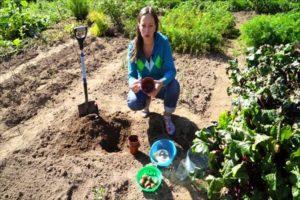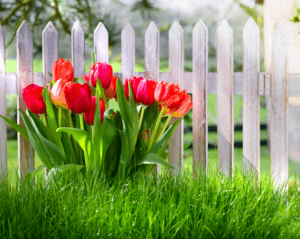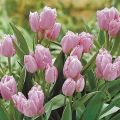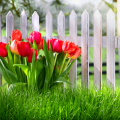When and how to plant tulips in different regions, terms
When to plant tulips, gardeners are interested. After the winter cold, I really want to decorate the dacha with primroses. But in order to get abundant and long-lasting flowering, you should choose the planting time wisely. Tulips are unpretentious plants. Popular varieties are successfully grown by gardeners. But new species require the implementation of the recommendations of agronomists.
Why plant tulips in autumn?
When determining the timing of planting, the characteristics of the plants should be taken into account:
- Tulips are bulbous plants. Their wild steppe ancestors bloom in early spring, then accumulate nutrients during the spring. In early summer, the plants shed their leaves and live like this until next spring. That is why it is right to plant tulip bulbs before winter.
- Tulips begin to bloom at temperatures slightly above freezing and short daylight hours. Therefore, plants planted in spring have a lost life cycle. They are unlikely to bloom this season. Most likely, the bulbs will not have enough nutrients for successful wintering, so the flowers will be weak in the next season.
- You should also consider the amount of precipitation. With an abundance of rains in early autumn, you need to postpone planting until later.
- It is important to consider soil temperature when planting. Bulbs are not placed in frozen soil: they will not be able to take root. If the planting time is missed, the onions should be planted in a container that must be stored in the basement, and in the spring, the container with sprouted plants should be transferred to the garden.
The bulbs planted on time will successfully overwinter and in the spring will delight the gardener with abundant flowering.
Planting dates in different regions
In different regions, autumn comes at different times, so there is no strictly defined time frame for planting bulbs. And in a specific area, it is recommended to take into account the peculiarities of autumn weather.
In the middle lane
The best time to plant tulips is between late August and late October. Plants must have time to take root, this is what guarantees that the bulbs will not freeze in winter.

In outskirts of Moscow
In the Moscow region, early autumn, dry and warm. Planting tulips is permissible from early September to mid-November. If the weather remains warm, the planting time can be extended until the end of November.
In the Urals, in Siberia
In the Urals and Siberia, the ideal landing time is late summer - early autumn. The disembarkation period is very short, because winter in these regions is coming rapidly.
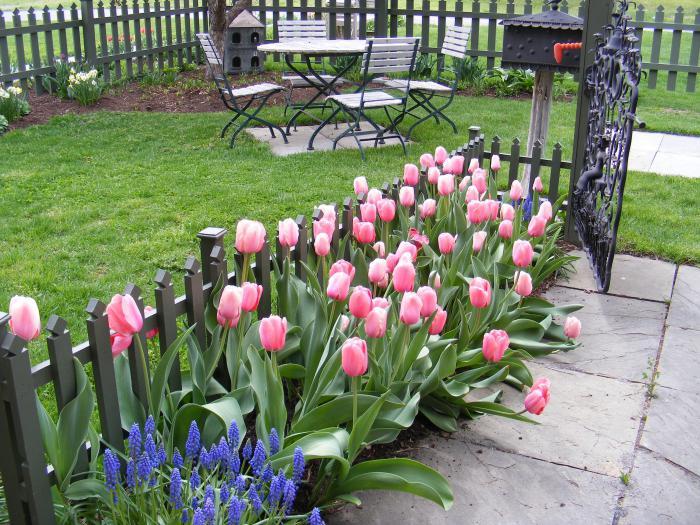
How to store tulips before planting in the fall
After the end of spring flowering, the onions are dug up and stored until autumn planting. During this period, it is recommended to follow the storage rules:
- The bulbs should be cleared of soil and carefully examined. Those damaged by pests and sick need to be discarded.
- The cover scales should be kept in place. It is important to leave the ground part (leaves) until it dries completely: nutrients must move to the underground part.
- The resulting babies should be separated from the mother's bulb: they need to be postponed and grown in the school.
- For disinfection, it is recommended to hold the material in a pink solution of potassium permanganate for 5 minutes. Then it needs to be dried on a paper towel.
- Prepared tulips should be arranged in one row on a flat baking sheet. It is recommended to cover the baking sheet with a metal mesh on top to protect it from rodents.
- The container with planting material must be placed in a dry, dark place: in a shed or in an attic. It is not necessary to observe the temperature regime: the wild ancestors of tulips survive the summer period at high, often unstable temperatures.
- It is recommended to spread mousetraps around for added protection from rodents.

It is important to store each tulip variety separately and mark the container with a name.
How to plant tulips?
Properly stored bulbs need to be planted correctly. The beauty of the garden in spring depends on it. Basic steps:
- choose a landing site;
- prepare the ground;
- prepare planting material;
- develop a landing pattern.
You should not rush to carry out the preparatory activities: it is important to perform them efficiently.

Seat selection
The summer resident is trying to plant tulips in a place that is open to view. But the main criterion is not entertainment. Plants require special conditions. At the dacha, a sunny place is suitable for placing bulbous plants, where snow melts first. But it should be away from melt water: tulips do not tolerate flooding, they get wet and rot. Surviving plants bloom little and reluctantly, buds are small.
Land preparation
Bulbous plants receive nutrition from the nutrients accumulated in the heads. Therefore, soil fertility is not taken into account in the first place. And you should pay attention to the structure of the soil.

The soil must be light, air and moisture permeable. Therefore, on heavy clay and loamy soils, it is recommended to carry out preparatory work: add sand with coarse fractions or neutral peat. Before planting in the garden, it is recommended to apply phosphorus-potassium fertilizers. Some summer residents use ready-made mineral complexes for feeding bulbs.
Preparing the bulbs
The autumn planting of tulips is carried out at a quiet time for the gardener: the main work is completed. But for the success of the event, you should follow the recommendations:
- When buying planting material in certified garden centers or proper spring-summer storage, special preparation for planting is not required.
- But when purchasing bulbs from your hands, it is recommended to check the plants for pest damage or disease. Material that has mechanical damage is also discarded.
- It is imperative to carry out disinfection in a solution of potassium permanganate. The solution should be light pink.

Healthy bulbs planted on time in spring will delight the gardener with abundant flowering.
Landing scheme
The gardener wants to create interesting compositions from different varieties and hybrids of tulips. To do this, you should know at what distance to place plants from each other.
The bulbs have different sizes, so it is recommended to follow the general rule: planting bulbs from each other is required at a distance of 1 diameter.
Germination rate depends on how deep the planting is. On light soils, tulips should be planted to a depth equal to twice the height of the bulb. On heavy (unstructured) soils, it is recommended to deepen to 1-1.5 heights. These rules are valid for outdoor planting. When placing the composition in a container, the depth decreases by the amount of the depth of the container.
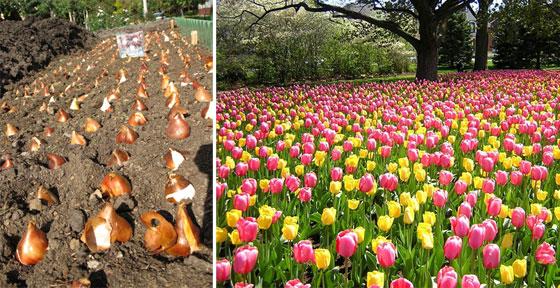
Further care
Tulips, planted correctly and on time, do not require special care: the bulbs will root well and overwinter. They should not be watered: with excessive moisture, they are easily affected by fungal diseases. Rooted bulbs hibernate at subzero temperatures without freezing. The gardener must correctly plant the plants: nature will do the rest.
Preparation for wintering
Onions love to gnaw mice during winter food deprivation. Therefore, it is recommended to cover the flowerbed with plants with spruce or pine spruce branches 15-20 cm thick: thorny branches will scare away rodents. In regions with severe winters, it is useful to cover plantings with hay on top of the spruce branches: this will warm them. During winter, you should regularly pile snow on the flower beds, make sure that there is no bare ground.
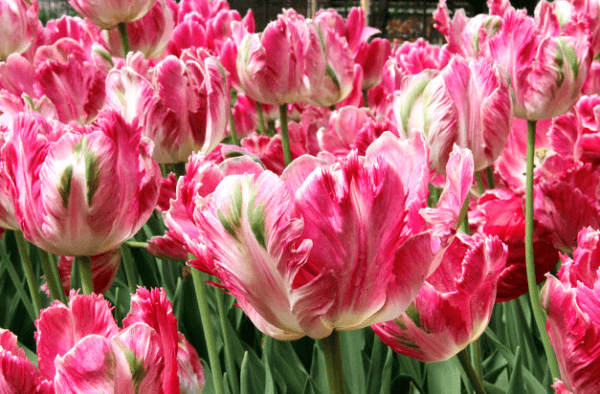
Useful tips for florists
It is useful to replant tulips every year to a new place. After flowering and yellowing of the leaves, they are dug up, dried and then planted in a prepared flower bed. It is recommended to adhere to the turnover of crops: after garlic, onions and gladioli do not plant, they have common diseases and pests. Tulips are returned to their original place in the 4th-5th year.
The appearance of stripes uncharacteristic for the variety on the leaves or petals of flowers indicates that the plants are affected by the variegation virus. This disease is incurable: all plants are burned, the soil is disinfected.
When digging, children are often lost, the gardener has to sift through the soil to find them. This problem can be easily solved by planting the bulbs in a special container with holes to drain off excess water. The container is buried in the ground to the required depth. Planting in a container allows you to quickly free up space for summer houses, which are grown through seedlings and placed in a flower bed.
Some gardeners plant bulbs in flower boxes. With this method of landscaping, planting is carried out immediately in the container. Then they are stored in the basement or wait for a stable snow cover and buried deeper into the snow. In the spring, the containers are placed in the required places in the garden.
